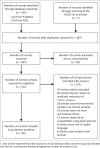Antimicrobial resistance of Vibrio cholerae from sub-Saharan Africa: A systematic review
- PMID: 30643734
- PMCID: PMC6325272
- DOI: 10.4102/ajlm.v7i2.778
Antimicrobial resistance of Vibrio cholerae from sub-Saharan Africa: A systematic review
Abstract
Background: The World Health Assembly adopted the Global Action Plan on Antimicrobial Resistance, which includes improving the knowledge base through surveillance and research. Noteworthily, the World Health Organization has advocated a Global Antimicrobial Resistance Surveillance System to address the plan's surveillance objective, with most African countries enrolling in or after 2017.
Aim: The aim of this article was to review prior data on antimicrobial resistance of Vibrio cholerae from sub-Saharan Africa with a view for future control and intervention strategies.
Methods: We used the Preferred Reporting Items for Systematic Review and Meta-Analysis (or 'PRISMA') guidelines to search the PubMed and African Journals Online databases, as well as additional articles provided by the Nigeria Centre for Disease Control, for articles reporting on the antibiotic susceptibility of V. cholerae between January 2000 and December 2017.
Results: We identified 340 publications, of which only 25 (reporting from 16 countries within the sub-Saharan African region) were eligible. The majority (20; 80.0%) of the cholera toxigenic V. cholerae isolates were of the serogroup O1 of the El Tor biotype with Ogawa and Inaba serotypes predominating. Resistance was predominantly documented to trimethoprim-sulphamethoxazole (50% of the studies), ampicillin (43.3% of the studies), chloramphenicol (43.3% of the studies) and streptomycin (30% of the studies). Resistance mechanisms were reported in 40% of the studies.
Conclusion: Our results demonstrate a documented antimicrobial resistance of V. cholerae to multiple antibiotic classes, including cell wall active agents and antimetabolites with evidence of phenotypic/genotypic resistance to fluoroquinolones.
Conflict of interest statement
The authors declare that they have no financial or personal relationships that may have inappropriately influenced them in writing this article.
Figures
References
-
- Safa A, Nair GB, Kong RYC. Evolution of new variants of Vibrio cholerae O1. Trends Microbiol [serial online]. 2010. [cited 2017 Jan 25];18:46–54. Available from: http://www.ncbi.nlm.nih.gov/pubmed/19942436 - PubMed
-
- WHO Cholera outbreak–assessing the outbreak response and improving preparedness [homepage on the Internet]. Global Task Force on Cholera Control, WHO/CDS/CPE/ZFK. 2004. [cited 2017 Jan 25]. Available from: www.who.int/cholera
-
- Kitaoka M, Miyata ST, Unterweger D, Pukatzki S. Antibiotic resistance mechanisms of Vibrio cholerae. J Med Microbiol [serial online]. 2011. [cited 2017 Feb 04];60:397–407. Available from: http://www.ncbi.nlm.nih.gov/pubmed/21252269 - PubMed
Publication types
Grants and funding
LinkOut - more resources
Full Text Sources

